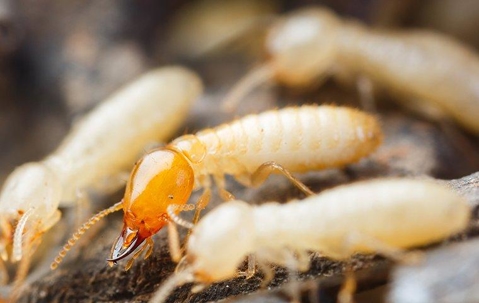The two most prevalent types found in this region include subterranean termites, and drywood termites. Subterranean termites build their nests underground, and travel back and forth each day to sources of wood. Subterranean termites prefer wood that contains significant moisture, such as within structures that have endured some water damage. Drywood termites tend to establish their nest within wooden structures, which offers them continual access to a food source. Drywood termites are generally larger compared to subterranean termites, and prefer wood that lacks any moisture. No matter the termite problem you are facing, we can help you rid your Santa Clarita area home of termites.
How Termites Damage Property
Termites pose a major year-round risk to properties, particularly those with structural components that were constructed using wood. Although most newly constructed homes and buildings are initially treated to prevent termites, many of these measures lose effectiveness over time. Once these pests begin consuming an area of wood, they will silently progress in rapid fashion. The most common areas where drywood termites are found include floors, wooden support beams, doors, and more. Subterranean termites typically invade hidden areas within walls, and above ceilings. Aside from permanently compromising wooden structures, termites also leave behind their excrement (frass), and promote the growth of mold.
What Are The Signs Of A Potential Termite Intrusion?
Appearance: Although the appearance of termites differs by species, they have some common characteristics. They typically range from ¼ to ½ of an inch long, have antennae, and are a white, tan, or brown color.
Swarms: Winged termites called alates are those involved in the annual mating ritual that tend to gather in termite swarms, and are often mistaken for flying ants. Property owners sometimes will notice small piles of their wings that they eventually shed.
Structural changes: Door and windows located near termite-infested structures may become increasingly difficult to open or close. Look for signs of bowing ceilings, or walls that develop watery patches.
Waste: The frass left behind appears as specs of ground coffee.
Do I Need A Professional Exterminator?
As with many types of unwanted critters, termites tend to stay out of plain sight and generally invade areas where the property owner rarely enters, such as interior walls and crawl spaces. This may result in a significant amount of the termite damage going unnoticed. Most people also have limited knowledge of the signs and indications that suggest a possible termite intrusion. Because of the likelihood that the colony has already done a considerable amount of damage, a prompt response is critical. Avoid taking shortcuts, such as by attempting fanciful home remedies. The same applies to store-bought products that are effectively marketed, yet tend to be largely ineffective in eliminating termite infestations. Instead, immediately speak with a local licensed professional that will thoroughly assess the extent of the problem, and develop the best solution.
Licensed Pest Control Company In Santa Clarita
For nearly 25 years now, the experts at CVA Exterminators have been meeting and exceeding the expectations of residential and commercial customers in the Santa Clarita region. This formula for lasting success is the result of a strong commitment to using the latest products and equipment available in the pest control industry, and ensuring that each of our customers is satisfied. Did you know that CVA Exterminators is now offering same-day and emergency response services for those with immediate pest-related concerns? We also prioritize the health and safety of our customers, and strive to employ techniques that protect both people and the local environment. Contact our team of experienced technicians today for a comprehensive termite inspection and treatment, and no-obligation estimate.

